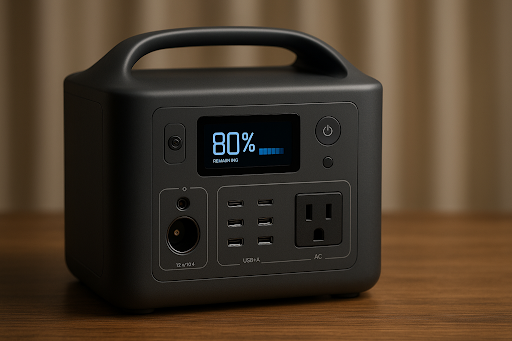The last decade has seen the “power station” evolve to include portable grids. New developments in battery chemistry, inverter technology, and portable designs enable small power units to be housed in garages, camper vans, and even living rooms. These small power stations offer silent and emission-free backup power, smart monitoring, and seamless integration with solar power. A decade ago, portable gas generators were the only option for access to power during blackouts and off-grid adventures. Everything is different now. After spending more than a decade covering energy innovations, I can confidently say that I witnessed the evolution of portable energy stations from niche gadgets to must-have items.
Home power stations are now more effective than traditional generators. It is now time to consider whether gas-powered generators are, in fact, on the fast track to retirement.
The Functionality of a Home Power Station
Essentially, a home power station is a rechargeable battery of sorts, but on a larger scale. In addition to built-in inverters, the power station comes with multiple outputs (AC, USB, and car sockets) and intelligent controls. Unlike traditional generators that burn fuel to create electricity, modern home power stations store energy for future use, much like a smartphone battery. Home power stations now range from portable 500-watt modules to sophisticated systems that exceed 3,000 watts. Most power stations allow pass-through charging, meaning you can power them whilst charging, and some even have LCD screens showing real-time metrics for load, time remaining, and charge status.
In 2015, I remember testing a portable 800-watt power station. While it used to take a long time to charge the power stations, and capacity was limited, I have now been able to carry units that weigh under 15 pounds and power a refrigerator for over six hours. Companies like Jackery, Goal Zero, and EcoFlow have made “power station” a keyword every homeowner searching for backup power solutions knows.
What Distinguishes Home Power Stations From Each Other
Battery Capacity and Chemistry
Home power stations utilize Lithium Iron Phosphate (LiFePO₄) batteries due to their longer cycle life and better safety measures. With these batteries, a 1,000-watt-hour LiFePO₄ pack can power smartphones, laptops, and even CPAP machines, or LED lights for multiple days during an outage. Some models even stack multiple batteries to increase capacity for whole-house backup power.
Smart Updates And Monitoring
Home power stations also offer solar, AC wall outlet, and car outlet charging options. With mobile applications that allow for charge set adjustments, recharge scheduling, and rate monitoring, one can track their power station like no other. This level of insight is a far cry from fuel gauge generators.
Portability and Modular Design
Home power stations are also made with wheels, handles, and stackable modules for effortless transport to needed locations. Most can even be tailored to certain needs, like remote work and tailgating. This is a far cry from gas generators that need to be transported in pickup trucks with jerry can fuel.
Emission-Free and Quiet at the Same Time
The majority of home power stations are silent. Emission fumes and engine noise are non-issues. Because of this, they can be used indoors and in neighborhoods with noise restrictions. Replacing a small gas generator with a lithium version in my basement workshop enhanced both the noise level and the risk of carbon monoxide to zero.
Emission and Noise Comparisons Between Home Power Stations and Traditional Generators
Environmental Impact and Noise
Home power stations emit less than 40 decibels, quieter than a household refrigerator. Alternatively, traditional generators emit carbon monoxide and particulate matter in addition to 60-90 decibels of noise, equivalent to power tools. Further to this, home power stations have the added benefit of zero emissions, making them more suitable for indoor use.
Reliability and Maintenance
In order for traditional generators to be functional, they require oil to be changed, spark plugs to be replaced, and new fuel to be added. Even worse, with time, fuel can degrade. On the other hand, battery-powered stations need firmware updates and battery health checks. These battery-powered stations require minimal maintenance and are highly dependable. After extensive testing, I have learned that power stations are much more dependable than fuel options. Power stations are much more dependable over time and in hundreds of cycles. Starting with a few reliable components ensures hundreds of cycles of dependability without mechanical failure unpredictability.
Cost of Ownership
A midrange gas generator’s upfront cost is $300, while a comparable 1,000-watt power station starts at $500. A generator’s fuel, oil, and maintenance costs can add hundreds of dollars each year. In contrast, electricity is cheaper, especially at off-peak times or during times when solar power is used. Many homeowners find that over five years, the breakeven point is reached with battery-based systems.
Performance During Extended Outages
Generators are best at running continuously for days at a time, as long as fuel is accessible. However, transporting and storing fuel can be a logistical challenge. Home power stations with solar panels can be recharged daily under sunlight, offering an effective “unlimited” supply. During a week-long outage in my neighborhood, a friend with a solar-integrated power station remained fully powered while others resorted to juggling rotating generator shifts and fuel runs.
Real-World Applications Outside of Emergency Backup
Off-Grid Living
These battery stations serve as primary hubs for cabin dwellers and are also used by tiny home enthusiasts. With a modest solar array, these systems can independently serve lighting, refrigeration, and communication gear without the need for gas.
Outdoor Adventures
For campers or overlanders, portable power stations can be conveniently stored in the back of trucks or even in backpacks. They help keep the base camps comfortable without the roar of an engine by charging phones, running mini coolers, and powering LED lanterns.
Mobile Offices
Photographers and freelancers can charge their laptops, cameras, and drones at remote locations from power stations. The quiet operation of power stations fosters focus as they do not make noise like traditional generators.
Home DIY Projects
During renovations, hobbyists and electricians appreciate the convenience of power stations for instant power. They make tasks like testing circuits in basements, powering tools, or running nail guns far easier where outlets and extension cords are lacking.
Selecting the Correct Power Station for Your Home
Evaluating Capacity Requirements
Combine the critical devices’ wattage and estimate the desired runtime. If you just need basic lighting and charging, 500 to 1000 watt-hours may suffice. For refrigerators, sump pumps, or even some medical devices, the estimate shifts to 1500 watt-hours or more.
Recharge Methods and Speed
How you refill a device matters. AC charging, for example, is often slow at 6 to 8 hours. Solar charging, however, depends on the sun and the size of the panel. Some devices are handy for daily use because they support rapid recharging of over an hour using high-power chargers.
Portability Versus Power Output
Heavier stations typically pack more power. If you plan to move it frequently, look for units under 30 pounds. For a semi‑permanent garage or utility closet installation, weight becomes less critical and higher‑capacity options shine.
Integration with Solar and Home Systems
If you already own solar panels, check compatibility. Many stations support MPPT charge controllers and seamless transfer switches for grid‑tie or off‑grid setups. This integration can turn a portable unit into a fixed emergency backup system.
The Future of Home Energy Backup
The pace of innovation in energy storage shows no sign of slowing. Next‑generation solid‑state batteries are likely to offer higher energy density and quicker charge times. Power stations may be able to offset grid-supplied energy to power stations, and earn credits for energy delivered during peak demand. Smart grid systems and vehicle-to-home (V2H) technologies could enable electric vehicles to serve as backup power in addition to their primary function, with the vehicle seamlessly shifting the boundary between transit and standby mode. Prices for components and systems are likely to set a new steady state, increasing the efficiency and appeal of power stations beyond niche interest.
Conclusion
Power generators have been benefits for homes for multiple decades, but home power stations are transforming these expectations through their user-friendly design, cleanliness, and intelligent features. These battery systems are compliant with renewable energy targets, reduce maintenance, and provide silent operation. For those who are tired of fuel storage and fighting with loud machines, a switch to power stations is greatly needed. It is clear their use is fading, but for now, generators still have a place while energy storage technology is on the rise.
Line of Questions
Home power stations use large battery packs to store electricity, while generators convert fuel to power, based on demand. Battery systems have reduced upkeep, make no emissions at the use site, and make less noise than generators, which require fuel and emit pollutants.
Can a power station fully replace a generator during long outages?
Your energy needs and recharge options both play a role. A power station can cover most essential loads during short outages or when recharging via solar panels or grid power. However, during long periods of low sunlight in winter, a generator with ample fuel reserves may still be necessary to power high-draw devices like electric heaters.
How long do modern power station batteries last?
Under normal conditions, most Lithium-iron-phosphate batteries installed in home power stations come with a warranty of 2,000-3,000 charge cycles. This translates to more than a decade of reliability when fully recharged on a weekly basis and can provide consistent backup capability long after warranty expiration.
Are home power stations cost-effective compared to generators?
Home power stations and generators often provide competing options, but a high-capacity power station comes with a higher price tag than basic generators. This is in part due to the cheaper overall operating costs of a generator. However, fuel and maintenance-free home power stations often provide better peace of mind, especially when combined with low-maintenance solar power, and become more cost-effective than traditional generators in the long run.
Is it complicated to install a solar-powered station?
Today’s solar-powered stations come with integrated MPPT solar charge controllers and come with basic wiring schematics, which simplify the setup a great deal. In most cases, it is just a matter of installing the solar panels, connecting them using an MC4 cable, and programming the charge instructions. This is a rather simple process that can be done in just a few hours by a handy, DIY inclined homeowner.

